Module 7: Woodlot Ecology: Your Living Woodlot
Lesson Seven - Woodlot Stewardship and Sustainability
We've learned that a good understanding of ecology can help woodlot owners make wise decisions about managing their land. This caring for and nurturing of the land is called stewardship. Good stewardship means that the land and the life in and around it is being properly tended.
Owning and managing a woodlot is a responsibility that should not be taken lightly. Whether you have inherited or purchased a woodlot, it is up to you to manage your woodlot sustainably. Sustainable resource management means using and protecting your woodlot resources in ways that provide for present economic, social and environmental well-being while conserving the potential of your woodlot for future generations.
We've seen how woodlots can be home to an incredible variety of life, both above and below the ground. Through best management practices, forest operations can be carried out on most woodlots without significantly damaging the environment. One forest harvesting system that has been over-used is clear cutting, in which most or all of the trees are removed from an area of forest. Clear cutting is used to manage even-aged stands of trees that are all ready for harvest at the same time. The decision to clear cut means that a woodlot owner can only harvest every 40 to 50 years, when the trees are mature again. As well, potential areas of wildlife habitat are removed when forest stands are completely harvested, and valuable nutrients are removed from the site.
Options exist for land owners who wish to manage their woodlots in holistic, ecosystem-based ways. Many owners have traditionally employed even-aged techniques, ensuring that most or all of the trees in a forest stand are within the same age class. This system of management is relatively easy and economical to implement. Silviculture treatments such as pre-commercial thinning, commercial thinning, clear cutting and shelterwood harvesting are commonly used to increase the growth of trees and establish new regeneration. Lessons in the use of all of these silviculture methods can be found in earlier modules of this series.
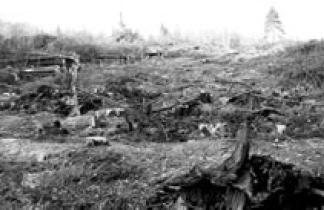 |
| Figure 62a: Whole tree harvesting removes many nutrients from a forest site. |
Uneven-aged management is adopted when woodlot owners wish to conserve a range of age classes of trees on their woodlots or in a forest stand. Selection harvesting is used to maintain a regime of partial cutting in which most of the poorest quality trees are removed early in the management cycle. The best quality crop trees can then be individually tended for maximum market value. Treatments which promote individual tree quality include crop tree release and crop tree pruning.
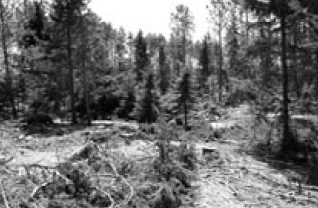 |
| Figure 63: Selection harvesting can be used to promote different age classes of trees in a woodlot. |
Both even-aged and uneven-aged management can be used to enhance wildlife habitat features. Be sure to leave as many snags and cavity trees as possible, and use caution near watercourses and vernal pools.
In accordance with provincial regulations, clumps of trees must be left standing in forest operations. The role of the clumps is to preserve a portion of the stand as legacy forest. Because the clump must be composed of the same tree species and tree sizes of the area being cut, some genetic material of the original stand will be preserved. Existing wildlife habitat will also be conserved. Where forest stands exhibit old forest characteristics, a forest biologist should be consulted to determine the best options for management.
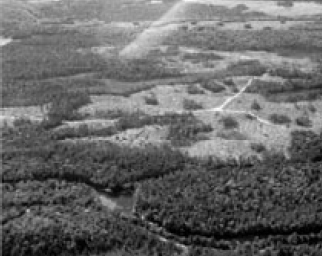 |
|
| Figure 64: Wildlife clumps are required to be left in clearcuts over 8 hectares in area. |
Care should be taken to avoid damaging forest soils during any forestry operation. By choosing the best season of the year to operate forestry vehicles, rutting and soil disturbance can be minimized. Where the soil is imperfectly or poorly drained, a winter operation may be the only option to avoid soil compaction and damage. Soil compaction results in the loss of soil porosity, and water will pond or run off if the soil loses its capacity to absorb water.
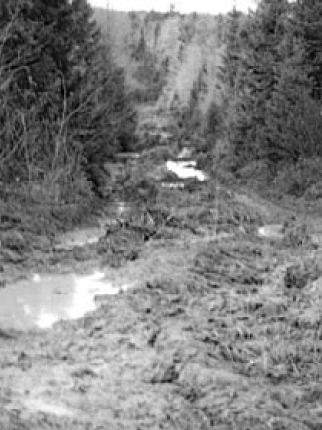 |
| Figure 65: Soil compaction and rutting can occur if forest opera-tions are improperly planned. |
A woodlot management plan is an important tool in determining the most appropriate steps to take in managing your woodlot. Your objectives are very important when planning the future of your forest, and a management plan will match the future potential of the resources on your woodlot to your objectives. Woodlot management plans are usually prepared by foresters and forest technicians who are familiar with the ecology of the forests of Nova Scotia.
Climate Change
Climate change is caused when carbon dioxide and methane, called greenhouse gases, are released into the atmosphere in such quantities that solar radiation which reaches the Earth's surface cannot escape. As the temperature changes within the atmosphere and at the surface of the Earth, the circulation of water and air are thrown off balance, and drought, flooding and wind storms become more frequent.
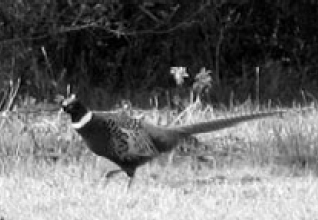 |
| Figure 66: Climate change may bring new wildlife species to Nova Scotia. |
In Nova Scotia, it is expected that temperature will increase by only a few degrees over the next century, but that will be enough to cause significant changes in the plant and animal communities that we are used to seeing. There may also be more precipitation in rain and snow, and wind events such as hurricanes may become more common and more severe during the autumn months. As the Acadian Forest slowly changes over the next few centuries, plants and animals that are found further south may become residents here.
Carbon levels in the atmosphere normally fluctuate over time, as the processes of carbon release and carbon capture occur. Healthy forests can slow the rate of climate change by absorbing greenhouse gases from the atmosphere. Trees are natural filters that "scrub" carbon dioxide and methane from the air before releasing it as oxygen. Without plentiful forests, the Earth's climate would change much more rapidly.
Integrated Resource Management
Integrated resource management is an important concept that promotes the use of forest management techniques to meet non-economic values such as conservation of wildlife habitat, protection of old-growth forest and preservation of views. Managing woodlots for multiple values is a concept shared by most woodlot owners.
We'll look at three examples of woodlot owners in Nova Scotia who have very different kinds of woodlots, but manage their properties for different values. You will see how a basic knowledge of woodlot ecology has helped them in planning and managing their resources. Similarly, a good understanding of forest ecology will allow you to make informed decisions about the future of your woodlot and the exciting possibilities that lay ahead.
 |
| Figure 67: Making wise woodlot management decisions is up to you. |
